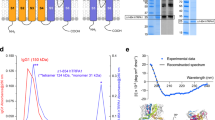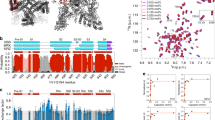Abstract
The subjective feeling of cold is mediated by the activation of TRPM8 channels in thermoreceptive neurons by cold or by cooling agents such as menthol. Here, we demonstrate a central role for phosphatidylinositol 4,5-bisphosphate (PI(4,5)P2) in the activation of recombinant TRPM8 channels by both cold and menthol. Moreover, we show that Ca2+ influx through these channels activates a Ca2+-sensitive phospholipase C and that the subsequent depletion of PI(4,5)P2 limits channel activity, serving as a unique mechanism for desensitization of TRPM8 channels. Finally, we find that mutation of conserved positive residues in the highly conserved proximal C-terminal TRP domain of TRPM8 and two other family members, TRPM5 and TRPV5, reduces the sensitivity of the channels for PI(4,5)P2 and increases inhibition by PI(4,5)P2 depletion. These data suggest that the TRP domain of these channels may serve as a PI(4,5)P2-interacting site and that regulation by PI(4,5)P2 is a common feature of members of the TRP channel family.
This is a preview of subscription content, access via your institution
Access options
Subscribe to this journal
Receive 12 print issues and online access
$209.00 per year
only $17.42 per issue
Buy this article
- Purchase on Springer Link
- Instant access to full article PDF
Prices may be subject to local taxes which are calculated during checkout








Similar content being viewed by others
References
Reid, G. & Flonta, M.L. Physiology. Cold current in thermoreceptive neurons. Nature 413, 480 (2001).
McKemy, D.D., Neuhausser, W.M. & Julius, D. Identification of a cold receptor reveals a general role for TRP channels in thermosensation. Nature 416, 52–58 (2002).
Peier, A.M. et al. A TRP channel that senses cold stimuli and menthol. Cell 108, 705–715 (2002).
Reid, G., Babes, A. & Pluteanu, F. A cold- and menthol-activated current in rat dorsal root ganglion neurones: properties and role in cold transduction. J. Physiol. (Lond.) 545, 595–614 (2002).
Voets, T. et al. The principle of temperature-dependent gating in cold- and heat-sensitive TRP channels. Nature 430, 748–754 (2004).
Brauchi, S., Orio, P. & Latorre, R. Clues to understanding cold sensation: thermodynamics and electrophysiological analysis of the cold receptor TRPM8. Proc. Natl. Acad. Sci. USA 101, 15494–15499 (2004).
Clapham, D.E., Runnels, L.W. & Strubing, C. The TRP ion channel family. Nat. Rev. Neurosci. 2, 387–396 (2001).
Montell, C. Physiology, phylogeny, and functions of the TRP superfamily of cation channels. Sci. STKE 2001, RE1 (2001).
Montell, C., Birnbaumer, L. & Flockerzi, V. The TRP channels, a remarkably functional family. Cell 108, 595–598 (2002).
Minke, B. & Cook, B. TRP channel proteins and signal transduction. Physiol. Rev. 82, 429–472 (2002).
Clapham, D.E. TRP channels as cellular sensors. Nature 426, 517–524 (2003).
Hilgemann, D.W., Feng, S. & Nasuhoglu, C. The complex and intriguing lives of PIP2 with ion channels and transporters. Sci. STKE 2001, RE19 (2001).
Huang, C.L., Feng, S. & Hilgemann, D.W. Direct activation of inward rectifier potassium channels by PIP2 and its stabilization by Gβγ. Nature 391, 803–806 (1998).
Sui, J.L., Petit Jacques, J. & Logothetis, D.E. Activation of the atrial KACh channel by the βγ subunits of G proteins or intracellular Na+ ions depends on the presence of phosphatidylinositol phosphates. Proc. Natl. Acad. Sci. USA 95, 1307–1312 (1998).
Zhang, H., He, C., Yan, X., Mirshahi, T. & Logothetis, D.E. Activation of inwardly rectifying K+ channels by distinct PtdIns(4,5)P2 interactions. Nat. Cell Biol. 1, 183–188 (1999).
Du, X. et al. Characteristic interactions with phosphatidylinositol 4,5-bisphosphate determine regulation of Kir channels by diverse modulators. J. Biol. Chem. 279, 37271–37281 (2004).
Hardie, R.C. Regulation of TRP channels via lipid second messengers. Annu. Rev. Physiol. 65, 735–759 (2003).
Runnels, L.W., Yue, L. & Clapham, D.E. The TRPM7 channel is inactivated by PIP2 hydrolysis. Nat. Cell Biol. 4, 329–336 (2002).
Liu, D. & Liman, E.R. Intracellular Ca2+ and the phospholipid PIP2 regulate the taste transduction ion channel TRPM5. Proc. Natl. Acad. Sci. USA 100, 15160–15165 (2003).
Liu, B. & Qin, F. Functional control of cold- and menthol-sensitive TRPM8 ion channels by phosphatidylinositol 4,5-bisphosphate. J. Neurosci. 25, 1674–1681 (2005).
Estacion, M., Sinkins, W.G. & Schilling, W.P. Regulation of Drosophila transient receptor potential-like (TrpL) channels by phospholipase C-dependent mechanisms. J. Physiol. (Lond.) 530, 1–19 (2001).
Chuang, H.H. et al. Bradykinin and nerve growth factor release the capsaicin receptor from PtdIns(4,5)P2 mediated inhibition. Nature 411, 957–962 (2001).
Lopes, C.M.B., Zhang, H., Rohács, T., Jin, T. & Logothetis, D.E. Alterations in conserved Kir channel-PIP2 interactions underlie channelopathies. Neuron 34, 933–944 (2002).
Zhang, H. et al. PIP2 activates KCNQ channels and its hydrolysis underlies receptor-mediated inhibition of M currents. Neuron 37, 963–975 (2003).
Rohács, T., Chen, J., Prestwich, G.D. & Logothetis, D.E. Distinct specificities of inwardly rectifying K+ channels for phosphoinositides. J. Biol. Chem. 274, 36065–36072 (1999).
Zeng, W.Z., Liou, H.H., Krishna, U.M., Falck, J.R. & Huang, C.L. Structural determinants and specificities for ROMK1-phosphoinositide interaction. Am. J. Physiol. Renal Physiol. 282, F826–F834 (2002).
Rohács, T. et al. Specificity of activation by phosphoinositides determines lipid regulation of Kir channels. Proc. Natl. Acad. Sci. USA 100, 745–750 (2003).
Fruman, D.A., Meyers, R.E. & Cantley, L.C. Phosphoinositide kinases. Annu. Rev. Biochem. 67, 481–507 (1998).
Kobrinsky, E., Mirshahi, T., Zhang, H., Jin, T. & Logothetis, D.E. Receptor-mediated hydrolysis of plasma membrane messenger PIP2 leads to K+ current desensitization. Nat. Cell Biol. 2, 507–514 (2000).
Prescott, E.D. & Julius, D. A modular PIP2 binding site as a determinant of capsaicin receptor sensitivity. Science 300, 1284–1288 (2003).
Cho, H., Nam, G.B., Lee, S.H., Earm, Y.E. & Ho, W.K. Phosphatidylinositol 4,5-bisphosphate is acting as a signal molecule in α1-adrenergic pathway via the modulation of acetylcholine-activated K+ channels in mouse atrial myocytes. J. Biol. Chem. 276, 159–164 (2001).
Valius, M., Bazenet, C. & Kazlauskas, A. Tyrosines 1021 and 1009 are phosphorylation sites in the carboxy terminus of the platelet-derived growth factor receptor-β subunit and are required for binding of phospholipase Cγ and a 64-kilodalton protein, respectively. Mol. Cell. Biol. 13, 133–143 (1993).
Ridefelt, P. & Siegbahn, A. Tyr1009 and Tyr1021 in the platelet-derived growth factor β-receptor mediate agonist triggered calcium signalling. Anticancer Res. 18, 1819–1825 (1998).
De Smedt, F., Verjans, B., Mailleux, P. & Erneux, C. Cloning and expression of human brain type I inositol 1,4,5-trisphosphate 5-phosphatase. High levels of mRNA in cerebellar Purkinje cells. FEBS Lett. 347, 69–72 (1994).
Luzzi, V., Sims, C.E., Soughayer, J.S. & Allbritton, N.L. The physiologic concentration of inositol 1,4,5-trisphosphate in the oocytes of Xenopus laevis. J. Biol. Chem. 273, 28657–28662 (1998).
Czirják, G., Petheő, G.L., Spät, A. & Enyedi, P. Inhibition of TASK-1 potassium channel by phospholipase C. Am. J. Physiol. Cell Physiol. 281, C700–C708 (2001).
Nakanishi, S., Catt, K.J. & Balla, T. A wortmannin-sensitive phosphatidylinositol 4-kinase that regulates hormone-sensitive pools of inositolphospholipids. Proc. Natl. Acad. Sci. USA 92, 5317–5321 (1995).
Chuang, H.H., Neuhausser, W.M. & Julius, D. The super-cooling agent icilin reveals a mechanism of coincidence detection by a temperature-sensitive TRP channel. Neuron 43, 859–869 (2004).
Garcia-Sanz, N. et al. Identification of a tetramerization domain in the C terminus of the vanilloid receptor. J. Neurosci. 24, 5307–5314 (2004).
Baukrowitz, T. et al. PIP2 and PIP as determinants for ATP inhibition of KATP channels. Science 282, 1141–1144 (1998).
Shyng, S.L., Cukras, C.A., Harwood, J. & Nichols, C.G. Structural determinants of PIP2 regulation of inward rectifier KATP channels. J. Gen. Physiol. 116, 599–608 (2000).
Dodier, Y. et al. Outer pore topology of the ECaC-TRPV5 channel by cysteine scan mutagenesis. J. Biol. Chem. 279, 6853–6862 (2004).
Schafer, K., Braun, H.A. & Hensel, H. Static and dynamic activity of cold receptors at various calcium levels. J. Neurophysiol. 47, 1017–1028 (1982).
Shyng, S.L. et al. Modulation of nucleotide sensitivity of ATP-sensitive potassium channels by phosphatidylinositol-4-phosphate 5-kinase. Proc. Natl. Acad. Sci. USA 97, 937–941 (2000).
van der Wal, J., Habets, R., Várnai, P., Balla, T. & Jalink, K. Monitoring agonist-induced phospholipase C activation in live cells by fluorescence resonance energy transfer. J. Biol. Chem. 276, 15337–15344 (2001).
Hirose, K., Kadowaki, S., Tanabe, M., Takeshima, H. & Iino, M. Spatiotemporal dynamics of inositol 1,4,5-trisphosphate that underlies complex Ca2+ mobilization patterns. Science 284, 1527–1530 (1999).
Rebecchi, M.J. & Pentyala, S.N. Structure, function, and control of phosphoinositide-specific phospholipase C. Physiol. Rev. 80, 1291–1335 (2000).
Allen, V., Swigart, P., Cheung, R., Cockcroft, S. & Katan, M. Regulation of inositol lipid-specific phospholipase cδ by changes in Ca2+ ion concentrations. Biochem. J. 327, 545–552 (1997).
Czech, M.P. Dynamics of phosphoinositides in membrane retrieval and insertion. Annu. Rev. Physiol. 65, 791–815 (2003).
Wenk, M.R. & De Camilli, P. Protein-lipid interactions and phosphoinositide metabolism in membrane traffic: insights from vesicle recycling in nerve terminals. Proc. Natl. Acad. Sci. USA 101, 8262–8269 (2004).
Acknowledgements
We thank E. Findeis and A. Pappas for preparing oocytes. The cDNA clone for the TRPM8 channel was kindly provided by D. Julius (University of California, San Francisco); the PDGF receptor clone by A. Kazlauskas (Harvard Medical School, Boston, Massachusetts); the CFP- and YFP-tagged PH domain constructs by T. Balla (National Institutes of Health, Bethesda, Maryland); the type I IP3 5-phosphatase by C. Erneux (IRIBHN, Brussels, Belgium); the clones for PLCδ1 and type I phosphatidylinositol-4-phosphate 5-kinase (PIP5K) by S. Scarlata (State University of New York at Stony Brook) and S.-L. Syng (Oregon Health & Science University, Portland); the clone for TRPV5 (CaT2) by L. Parent (University of Montreal); and the clone for TRPM5 by R. Margolskee (Mount Sinai School of Medicine, New York). This work was supported by NIH grant HL59949 to D.L. T.R. and C.M.B.L. were supported by Scientist Development Grants from the American Heart Association.
Author information
Authors and Affiliations
Corresponding author
Ethics declarations
Competing interests
The authors declare no competing financial interests.
Supplementary information
Supplementary Fig. 1
PI(4,5)P2 induces a shift in the voltage dependence of TRPM8 channels. (PDF 1480 kb)
Supplementary Fig. 2
Phospholipase C is required for PDGFinhibition of TrpM8 mutants. (PDF 1856 kb)
Supplementary Fig. 3
Inhibition of the endogenous Ca2+ activated Cl− current in Cl-free media. (PDF 670 kb)
Supplementary Fig. 4
Multiple sequence alignment of the Trp-domain of the mammalian Trp superfamily. (PDF 1204 kb)
Supplementary Fig. 5
Intracellular calcium concentration measurements. (PDF 1617 kb)
Supplementary Fig. 6
Model of the activation and desensitization of TRPM8 channels. (PDF 642 kb)
Rights and permissions
About this article
Cite this article
Rohács, T., Lopes, C., Michailidis, I. et al. PI(4,5)P2 regulates the activation and desensitization of TRPM8 channels through the TRP domain. Nat Neurosci 8, 626–634 (2005). https://doi.org/10.1038/nn1451
Received:
Accepted:
Published:
Issue Date:
DOI: https://doi.org/10.1038/nn1451
This article is cited by
-
TRPM channels in health and disease
Nature Reviews Nephrology (2024)
-
Structural basis of the activation of TRPV5 channels by long-chain acyl-Coenzyme-A
Nature Communications (2023)
-
The LCK-14-3-3ζ-TRPM8 axis regulates TRPM8 function/assembly and promotes pancreatic cancer malignancy
Cell Death & Disease (2022)
-
Critical contributions of pre-S1 shoulder and distal TRP box in DAG-activated TRPC6 channel by PIP2 regulation
Scientific Reports (2022)
-
Structural basis for promiscuous action of monoterpenes on TRP channels
Communications Biology (2021)



